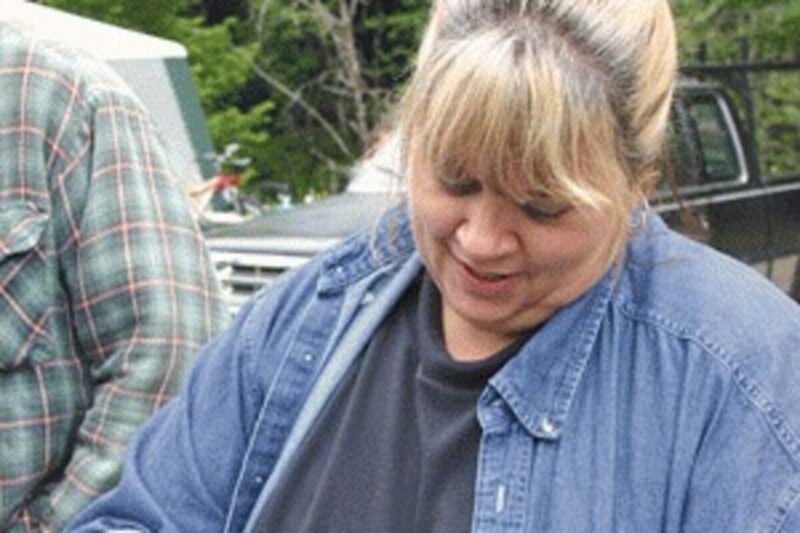Sean C. Morgan
Of The New Era
Rita Houston tapped her pan as she poured water over the edge, assuring a group of onlookers that it’s OK to aggressively tap the pan to clear sand away from the gold.
Gold is heavy, and ridges on the sides of the pan catch the precious metal so it doesn’t rush over the edge with the lighter sand. Houston used a magnet to remove black sand from the pan.
Slowly, flakes of gold became apparent among the remaining grains of sand.
Houston, owner and operator of Oregon Prospecting and Rita’s Relics, hosted a gold mining demonstration on the Quartzville Corridor, about 19 miles up Quartzville Road from Highway 20, on Saturday.
Her third annual demonstration drew at least 90 people, up from about 40 last year and 30 the first year. The event is free to anyone interested, and people are asking Rita to do it more than once a year.
Houston and her husband, Steve, camped on Friday so they could be there to meet those attending the demonstration. Several people joined them in the campout on Friday night.
Most of the would-be prospectors came from out of town, staying in local hotels and eating at local restaurants, Rita Houston noted. The Quartzville Corridor attracts wide interest with its nine miles of public mining. No claims can be made in the corridor.
“It’s our customers,” Rita said, of those who make trips up the corridor to seek their fortune.
“Some coming are just curious,” Steve said.
Greg Hodges of Eugene said he and his son had come up with his father to try their hand at prospecting. “We’re just doing the sluice box, metal detectors and stuff, kind of seeing how it works,” Hodges said.
Chris Hegge of Sweet Home said he enjoys the experience.
“It’s just a chance to get up and play in the river,” Hegge said. He has panned for gold before, and “one time, I had one flake on my own,” in the Applegate area.
Hegge said he was thinking about buying a pan, but he thought the $400 sluice outfit was a bit much for his interest level. He figured he would pick up one of the $10 pans.
Panning gives him “something to get out in the river and play, splash around a little bit,” Hegge said. “It gets me out here. It gets me out in the woods. It’s just an excuse to get out.”
The day started out with an introduction to portable dredges and sluice boxes, presented by Louie Frick of Oregon Fine Recovery and Welding. He demonstrated what is called “high-banking,” a process in which material is removed from above the water line in a stream channel, and then water is used to wash through the material, leaving gold.
Steve Houston, who was helping his wife with the program, demonstrated sluicing and gold panning. At the end of the day, he gave a demonstration in metal detectors.
Through it all, visitors were able to learn about some 20 different options for gold pans and other equipment for finding gold.
“Metal detectors take a little more one-on-one time,” Rita Houston said. “That’s part of the service I offer.”
Gold panning and recreational gold mining is considered the fastest-growing family hobby right now, she said. It makes sense with gold prices being about as high as ever since the 1980s. Prices recently reached more than $700 per ounce and are at about $609 per ounce right now.
Whether they find gold or not, it gives families something to do together, she said. It can appeal to families or individuals.
“Our daughter grew up on the river,” Steve Houston said.
He introduced his wife to gold fever about 20 years ago, she said.
“Gold mining is my passion,” Rita Houston said. “That’s where my heart lies.”
Steve Houston said he grew up in Quincy, Wash., between Wenatchee and Moses Lake, where a group of miners in the late 1860s had been attacked by Indians. The miners buried their gold, killed their mules and stashed the harnesses.
Most of those miners were killed crossing the Columbia River, Houston said. Legend had it the stash of gold was buried within two miles of the harnesses.
“The harnesses were found, but the gold was never found,” Steve said. As far as anyone knows, it’s still there.
That fed his fever, and Steve bought his first metal detector, a White’s Electronics Coinmaster II, in 1971.
He never found the gold, and he moved on to other hobbies. About 20 years ago, he took Rita back to the area, and they both became intensely interested in finding gold.
They ran a mining shop on the side, while working other jobs in Reedsport for 10 years.
“When we moved here six years ago, I was bored,” Rita Houston said, so she purchased a Main Street business, which became Oregon Prospecting and Rita’s Relics.
She said she looked forward to the demonstration last week.
“I love it. It’s just good people,” she said.





